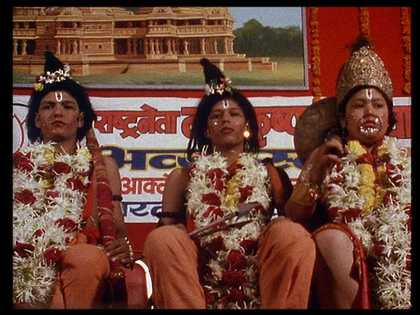Ram Ke Nam/In the Name of God
India 1991, 16 mm, 75 min, Hindi, English subtitles
In the Name of God studies the ways in which Hindu fundamentalism stages and mobilises the religious iconography of the warrior god Ram against Muslim communities thereby inciting Hindus to turn upon their neighbours with murderous intent. A roadside hoarding depicts Lord Ram, bow in right hand, arrow in his left, sheaf of arrows strapped behind him, towering above his temple. Next to Ram is the face of L.K. Advani, the leader of the VHP fundamentalist party, the politician intent on leading a crusade to destroy the 16th-century Babri mosque in Ayodha and build the temple in the supposed birthplace of Ram. In the Name of God follows L.K. Advaniās journey towards Ayodha in an air-conditioned Toyota built to resemble a rath or religious chariot. Behind him is a flotilla of flatbed trucks, draped with saffron garlands and crowded with men wearing saffron headbands, holding saffron flags and three children wearing the wigs, armbands, headpieces and jewellery of Ram, inciting riots as it goes. In this instance, Advaniās promise to build the temple was unsuccessful. But the government delayed the national broadcast of In the Name of God. By the time of its broadcast in 1996, the filmās warnings against imminent communal violence, voiced throughout the film, had long come true. In December 1992, fundamentalists finally succeeded in storming and destroying the Babri mosque as promised, unleashing reprisals and counter-reprisals between Muslims and Hindus across India.
Curated by . Followed by response and audience discussion with , Kodwo Eshun, Anjalika Sagar and .
- Download the programme notesĀ [PDF, 5.8MB]

